APHG agriculture practice quizzes
1/90
There's no tags or description
Looks like no tags are added yet.
Name | Mastery | Learn | Test | Matching | Spaced |
|---|
No study sessions yet.
91 Terms
Which of the following is NOT a characteristic of the Green Agriculture Revolution
A. use of pesticides and herbicides
b. Molecular and cellular manipulation of seed production
c. use of fertilized to promote growth and resistance against pests and droughts
d. causes pollution with water point source run-off or groundwater pollution
b. Molecular and cellular manipulation of seed production
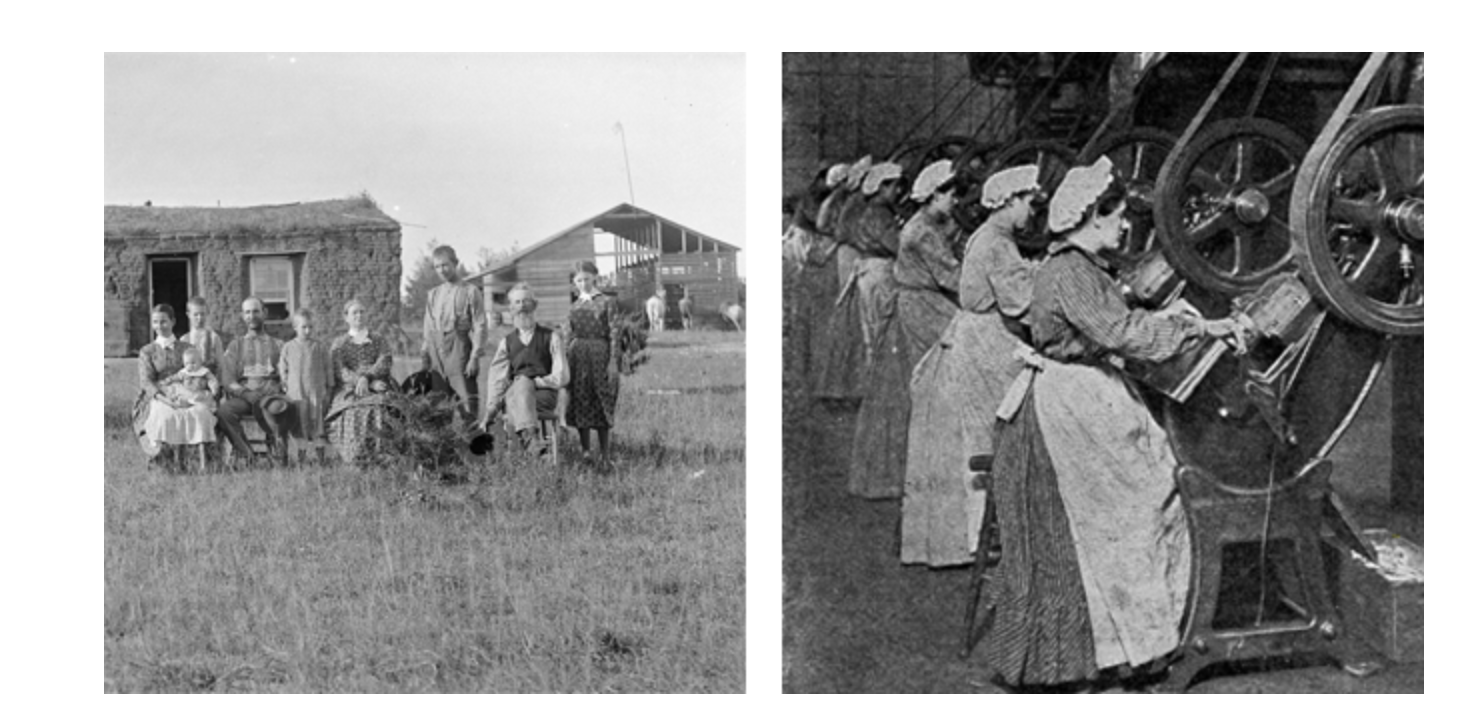
The images shown illustrate a change that took place as the Second Agricultural Revolution coincided with the Industrial Revolution. Which of the following compares this geographic relationship between these revolutions?
a. The mechanization of farm work allowed many young people to migrate and join a growing urban industrial workforce
b. An increase in chemical farming practices let to more food being produced by farmers and then processed in factories
c. The creation of sedentary societies, where farm work was done completely by machine, resulted in permanent settlements in town and cities
d. An increase in the rural farming workforce lead to higher farm productivity, which resulted in more food for urban industrial workers
e. The domestication of plants and animals allowed for factory farming practices where workers made the first canned foods
a. The mechanization of farm work allowed many young people to migrate and join a growing urban industrial workforce
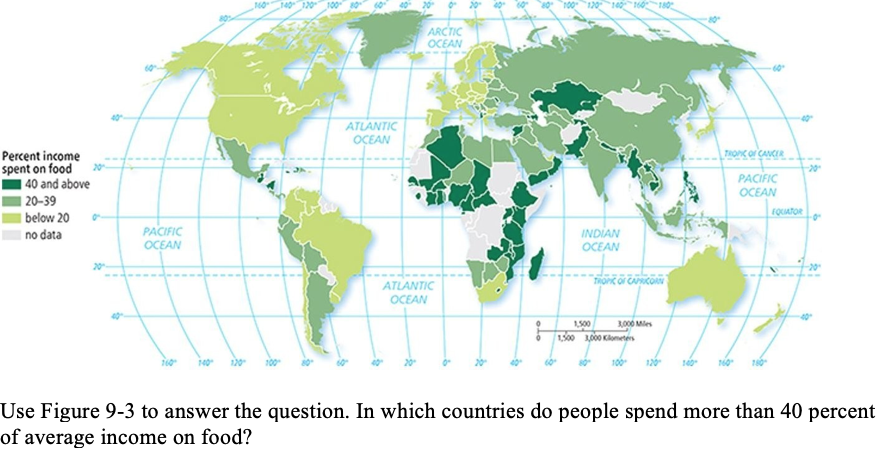
a. Syria, Iraq, Laos, Mexico, and Canada
b. Syria, Malawi, Kenya, Australia, and Madagascar
c. Algeria, Syria, Madagascar, and Laos
d. Madagascar, Mexico, Brazil, Guatemala, Syria, and Laos
e. Laos, Cuba, Brazil, and Madagascar
c. Algeria, Syria, Madagascar, and Laos
Dramatic increases in global grain production since 1950 have been made possible by
a. an increase in the urban workforce
b. an increase in the agricultural workforce
c. global warming
d. substantial increases in the amount of land under cultivation
e. an increase in the use of energy and technology
e. an increase in the use of energy and technology
Dietary energy consumption is best defined as
a. the number of calories in relation to diet.
b. the average food consumption worldwide per day.
c. the amount of food that an individual consumes.
d. the number of calories in a meal.
e. the amount of energy absorbed per calorie.
c. the amount of food that an individual consumes.
Corn (maize) was first domesticated in:
a. Central Australia
b. Central Mexico
c. the Canadian prairie
d. Northern Argentina
e. the Tibetan plateau
b. Central Mexico
A common difference(s) between farms in an LDC (like Pakistan) vs. farms in an MDC (like the United States) that grow the same crop is:
a. the amount of crop produced in a year
b. whether the crop is eaten off the farm or on the farm
c. the income derived from crops
d. A, B, and C are all correct
d. A, B, and C are all correct
Farming varies around the world because of ________ across space.
a. cultural and environmental factors
b. tropical climates had advantage with prime agricultural land
c. weather and climate
d. religious and economic factors
e. farmer personal preference and environmental factors
a. cultural and environmental factors
Most of the farming Asian countries is:
a. Intensive Subsistence
b. Commercial
c. Sustainable
d. Subsistence
a. Intensive Subsistence
Which of the following explains the diffusion and successful cultivation of many plants and animals in new regions of the world through the Columbian Exchange?
a. Diffusion of plants and animals filled the loss in many areas from a number of plant and animal extinctions.
b. The plants and animals diffused to regions with variation in the climates between the hearth and the new region.
c. The plants and animals diffused to a region with climate and geography similar to that of their point of domestication.
d. The plants and animals diffused only a short distance away from their point of domestication.
e. Navigational technology allowed ships to travel more efficiently, enabling safe transport of plants and animals to new destinations.
c. The plants and animals diffused to a region with climate and geography similar to that of their point of domestication.
The fact that meat accounts for one-third of all protein intake in developed countries but only one-tenth in developing ones suggests
a. developing nations are vegetarians by choice
b. developing nations do not have sufficient grazing land.
c. developed nations do not produce sufficient grains to replace meat consumption.
d. there is a cultural taboo against meat in developing nations.
e. developed nations can afford more meat per capita.
e. developed nations can afford more meat per capita.
The term used to describe a situation in which a person is able to access healthy and affordable food on a regular basis is
a. nourishment.
b. food desert.
c. social security.
d. affluence.
e. food security.
e. food security.
In less developed countries, pesticides are typically applied by hand, whereas pesticides are typically applied by tractors or aircraft in more developed countries. Which of the following best explains the risks associated with pesticide applications?
a. Contract harvesters are at risk in more developed countries, whereas environmental pollution is a risk in less developed countries.
b. Farmers' health is at risk in less developed countries, whereas environmental pollution is a risk in more developed countries.
c. Crop dusters are at risk when applying pesticides with aircraft in more developed countries, whereas environmental pollution is a risk in less developed countries.
d. Farm animals used to plow fields are at risk from pesticides in more developed countries, whereas environmental pollution is a risk is less developed countries.
e. Crops are at risk in more developed countries, whereas environmental pollution is a risk in less developed countries.
b. Farmers' health is at risk in less developed countries, whereas environmental pollution is a risk in more developed countries.
An important agricultural hearth is/are:
a. Southeast Asia.
b. South America
c. Southwest Asia
d. East Asia
e. All of the above
e. All of the above
Production of agricultural products destined primarily for direct consumption by the producer rather than for market is called
a. subsistence agriculture
b. hunting and gathering
c. plantation farming
d. shifting cultivation
e. sedentary cultivation
a. subsistence agriculture
The most important distinction for dividing the world into agricultural regions is:
a. the type of government
b. whether the product is consumed on or off the farm.
c. the location of the first agricultural hearth
d. the population density of the crop-producing region
e. whether crops are grown or animals are raised.
b. whether the product is consumed on or off the farm.
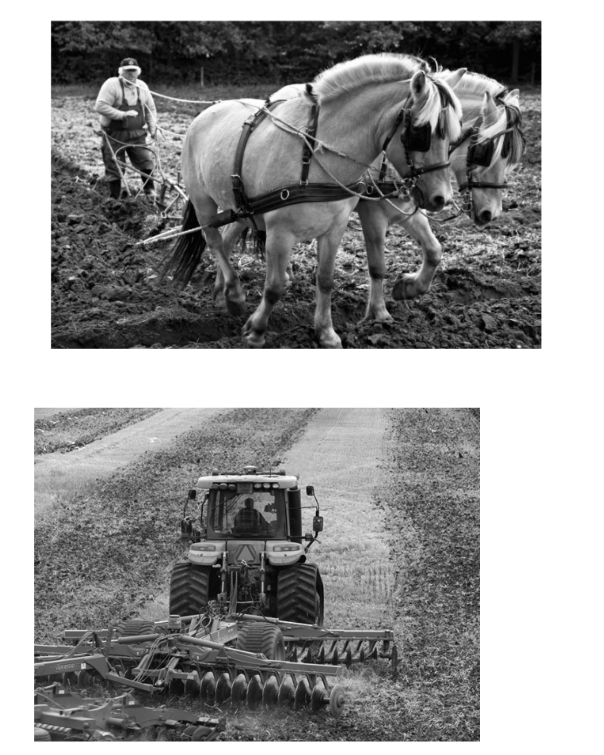
The two images show different agricultural methods. In the context of the Second Agricultural Revolution, which of the following trends is represented in these images?
a. The introduction of machines during the Second Agricultural Revolution resulted in many farmers being pushed off their land, leading to famine and starvation in the countryside.
b. Although new farm machines were developed during the Second Agricultural Revolution, many farmers continued to practice agriculture in traditional ways because of cultural taboos associated with the adoption of modern farming techniques.
c. During the Second Agricultural Revolution, many farmers continued to use traditional farming techniques that were more suited to the tropical environments they lived in.
d. The mechanization of farming in the Second Agricultural Revolution resulted in more reliable crop harvests and healthier populations in areas where the mechanization was adopted.
e. The developments associated with the Second Agricultural Revolution were applicable only to farmers growing grain in temperate regions of the world.
d. The mechanization of farming in the Second Agricultural Revolution resulted in more reliable crop harvests and healthier populations in areas where the mechanization was adopted.
Which of the following explains why multiple early hearths of domestication and diffusion of plants and animals arose across the world in Central America, the Fertile Crescent, the Indus River valley, and Southeast Asia?
a. Domestication of plants and animals began in Southeast Asia and the process diffused to other areas as nomadic warriors conquered other cultural groups and carried the new seeds and animals with them.
b. Domestication of plants and animals evolved in each hearth independently of one another as societies in each area learned and applied the process to local plants and animals.
c. Domestication of plants and animals began in the Indus River valley and the process diffused to other areas across trade routes.
d. Domestication of plants and animals began in Central America and the process diffused to other areas through the early explorers.
e. Domestication of plants and animals began in the Fertile Crescent and the process diffused as pastoral nomads migrated to other areas.
b. Domestication of plants and animals evolved in each hearth independently of one another as societies in each area learned and applied the process to local plants and animals.
Which of the following best explains the diffusion of plants and animals from their hearths of domestication?
a. Domesticated plants spread through wind-borne dispersal of seeds from their original hearth, expanding slowly until a vast region was covered with new plants.
b. The diffusion of plants and animals was dependent on nomadic traders who traveled between agricultural villages because early farmers were sedentary and did not travel to other areas.
c. Domesticated plants spread through wind-borne dispersal of seeds from their original hearth, expanding slowly until a vast region was covered with new plants.
d. Both domesticated plants and animals spread across the globe through contagious diffusion in early years by farmers and traders, and later by relocation diffusion through European exploration and colonialism.
e. The diffusion of plants and animals was limited to areas close to each hearth of domestication because the newly developed plants and animals could not readily adapt to different soil types.
d. Both domesticated plants and animals spread across the globe through contagious diffusion in early years by farmers and traders, and later by relocation diffusion through European exploration and colonialism.
In contrast to practitioners of agriculture, hunters and gatherers:
a. live in large groups.
b. travel frequently.
c. cultivate plants from a variety of hearths.
d. live near the center of world settlements.
e. domesticate animals.
b. travel frequently.
The most important distinction for differentiated the Neolithic Agricultural Revolution and Industrial Agricultural Revolution?
a. the location of the first agricultural hearths
b. whether crops are grown or animals are raised.
c. farm size increased and the number of farmers decreased
d. whether the product was a carbohydrate or a protein
c. farm size increased and the number of farmers decreased
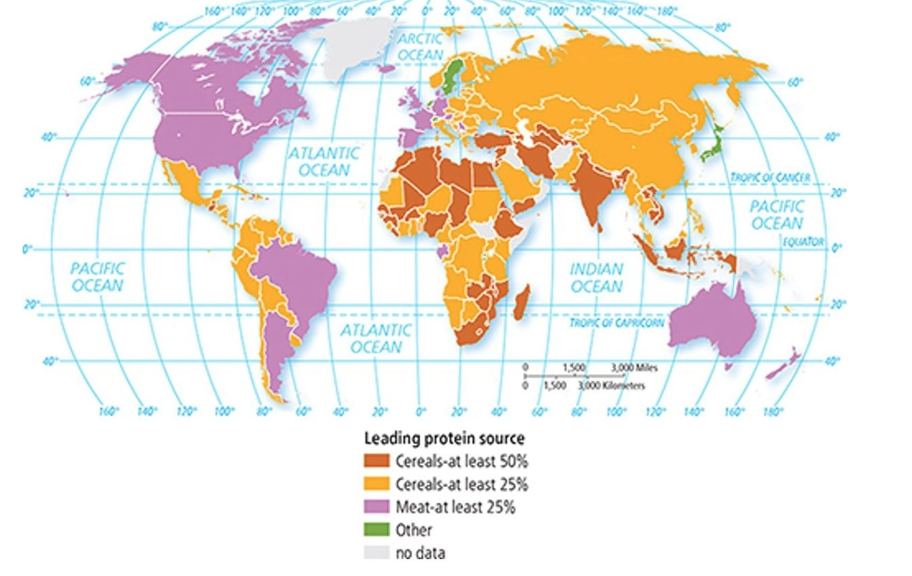
Use Figure 9-6 to answer the question. As demonstrated in this map of worldwide protein sources, which of the following statements is TRUE?
a. Sweden and Japan have a shortage of protein in the diet.
b. Developing countries have a high demand for meat products.
c. Nations in the northern hemisphere get most of their protein from cereals.
d. Europeans eat too much meat.
e. Cereals make up the largest protein source for most developing countries.
e. Cereals make up the largest protein source for most developing countries.
Which statement correctly describes hunting and gathering?
a. All humans obtained their food this way before the invention of agriculture.
b. It is a form of nomadism.
c. This form of subsistence is still practiced, but declining rapidly
d. all of the above
d. all of the above
Green Revolution technology has resulted in which of the following in modern agriculture?
a. The loss of prime agricultural land and smaller yields from grain crops
b. The end of famine in the world
c. An increase in the circulation of investment capital to help the poorest farmers
d. The construction of new irrigation systems and a reduction in the use of fertilizers
e. The development of high-yield grains and the expansion of cultivated areas
e. The development of high-yield grains and the expansion of cultivated areas
During the Green Revolution, agricultural practices from more developed countries diffused to less developed countries in Asia and Africa. Which of the following best explains the Green Revolution's highly variable level of success in increasing agricultural yields?
a. Persistent famine has occurred in India since new technologies associated with the Green Revolution were implemented because only the wealthy could afford the increased cost of the improved strains of rice.
b. The increased yield of the Green Revolution in sub-Saharan Africa decreased the incidence of famine, but the program was unsuccessful in India because of poor soil quality.
c. Incorrect. The Green Revolution was successful in China, where the new strain of rice increased production of rice by over 50 percent and led to a drastic decrease in hunger in the last decades of the twentieth century.
d. Small-scale farmers in Asia often lacked the resources necessary to acquire the hybrid seeds and the chemical inputs to grow them, leaving large gaps in the success of the Green Revolution outside of urban cores.
e. The Green Revolution was not successful in China because the strain of rice produced was prone to widespread crop failures, and China dropped out of the program.
d. Small-scale farmers in Asia often lacked the resources necessary to acquire the hybrid seeds and the chemical inputs to grow them, leaving large gaps in the success of the Green Revolution outside of urban cores.
Between 1950 and 1990, wheat production in India in average pounds per acre more than tripled, which allowed India to meet its population’s need for food. Which of the following best explains this change?
a. The use of large farm tractors and combine harvesters
b. The use of improved plant hybrids and agricultural chemicals
c. The increase in microloan programs that provide farmers with credit
d. The elimination of poverty in India’s rural regions
e. The use of genetically modified seeds
b. The use of improved plant hybrids and agricultural chemicals
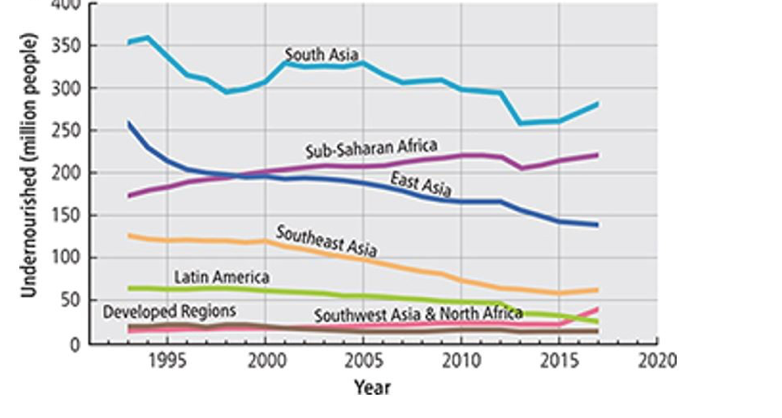
Use Figure 9-2 to answer the question. In which region has there been a recent decrease in the number of undernourished?
a. Southwest Asia & North Africa
b. South Asia
c. Sub-Saharan Africa
d. East Asia
e. southeast asia
d. East Asia
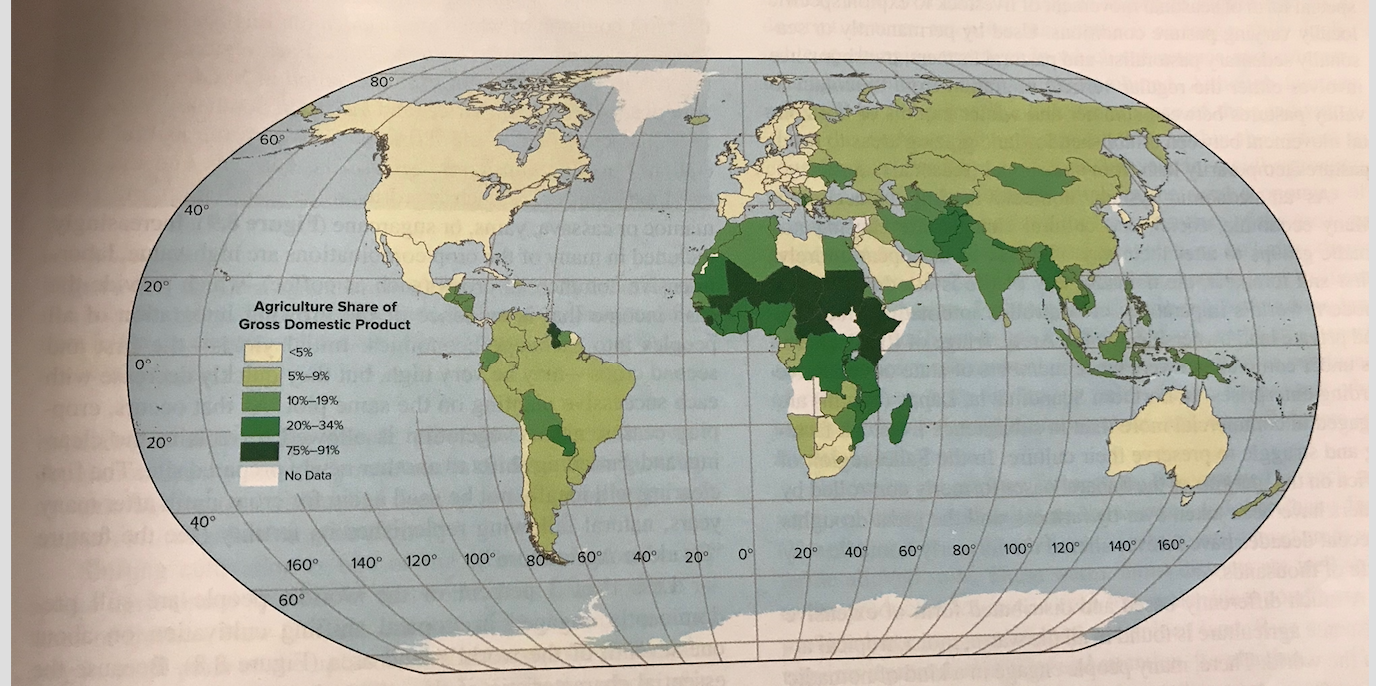
According to map above. the largest area of the world in which agriculture makes the largest contribution to the GDP (Gross Domestic Production) is?
a. North Africa
b. south America
c. southeast asia
d. sub Saharan africa
e. North America
d. sub saharan africa
Which of the following includes the world's earliest centers of plant domestication?
a. Russia, China, Latin America
b. Australia, New Zealand, China
c. Southeast Asia, Mesoamerica, Middle East
d. Northeast Asia, Eastern Europe, South Africa
e. It owes its origins to the domestication of animals.
c. Southeast Asia, Mesoamerica, Middle East
According to Carl Sauer, which of the following is true about plant domestication?
a. It was developed by farmers who were starving and desperate for food.
b. It was at first dependent on irrigation.
c. It originated in marginal areas with limited food resources.
d. It first occurred in diversified habitats with a variety of species.
e. It owes its origins to the domestication of animals.
d. It first occurred in diversified habitats with a variety of species.
Traditionally, the Ganges Valley and the Nile Valley have had comparatively high population densities because of their
a. . in-migration from neighboring arid areas
b. heavy industrialization
c. designation as sacred sites
d. intensive agriculture based on irrigation
e. tropical climate
d. intensive agriculture based on irrigation
Which of the following is an explanation for the similar impact of large-scale commercial agriculture in developed countries and plantation agriculture in developing countries?
A. Both farming practices guarantee that long-term sustainable farming methods will be incorporated in their production processes.
b. Both farming practices stimulate local economies with the influx of profits from export-oriented crops.
c. Both farming practices involve the consolidation of family farms and displacement of rural communities.
d. Both farming practices provide an increased standard of living in rural communities from the many jobs created to run these large farms.
e. Both farming practices enable local farmers to remain on their land rather than migrating to jobs in urban areas.
c. Both farming practices involve the consolidation of family farms and displacement of rural communities.
Subsistence agriculture (Sfiting Cultivation) is most common in which of the following regions?
a. The Ruhr Valley of Germany
b. The Outback of Australia
c. Pampas of Argentina
d. Amazon Basin
e. Great Plains of the United States
d. Amazon Basin
Undernourishment is most severe in:
a. Sub-Shaharan Africa
b. east asia
c. southeast asia
d. south asia
e. north africa
a. Sub-Shaharan Africa
During the winter months in North America, the primary source of fruits and vegetables found in grocery stores is
a. italy
b. nigeria
c. uruguay
d. philippines
e. chile
e. chile
Which is not a characteristic of shifting cultivation?
a. Land is cleared by slashing the vegetation
b. Debris is burned to provide the soil with nutrients.
c. A new site is designated every few years.
d. All of the above are characteristics.
e. Only choice 1 and 2 are correct
d. All of the above are characteristics.
Which of the following best explains why farmers would plant both strawberries and watermelons in the same field?
a. Limited farmland encourages intensive farming with intercropping to produce high yields.
b. Limited farmland encourages intensive farming and monocropping to produce high yields.
c. Limited farmland encourages extensive farming with monocropping to produce high yields.
d. Unlimited farmland encourages intensive farming with intercropping to produce high yields.
e. Unlimited farmland encourages extensive farming with intercropping to produce high yields.
a. Limited farmland encourages intensive farming with intercropping to produce high yields.
Which of the following is a subsistence crop?
a. rubber
b. cocoa
c. corn
d. timber
e. cotton
c. corn
Compared to North American ranchers, commercial ranchers in the Pampas of Argentina, Uruguay, and southern Brazil are more likely to
a. lease their grazing land
b. use practices developed by indigenous people
c. rely on feedlots
d. raise mostly sheep
e. raise livestock primarily for export
e. raise livestock primarily for export
Which type of agriculture is practiced by the largest percentage of the world's people?
a. intensive subsistence
b. hunting and gathering
c. pastoral nomadism
d. shifting cultivation.
a. intensive subsistence
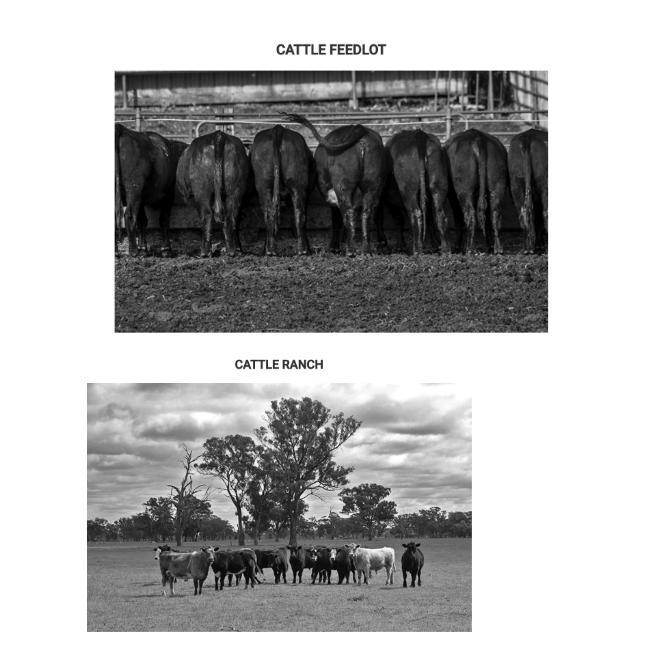
The two images represent two different methods of raising livestock in the United States. Which of the following statements most accurately compares these two agricultural practices?
a. Feedlots can minimize costs associated with livestock production because feedlots do not use as much space as cattle ranching.
b. Consumers prefer to pay higher prices for grass-fed beef than for corn-fed beef raised in feedlots because of the environmentally friendly practices associated with grass-fed beef.
c. Feedlots require more space than cattle ranching does, which reduces profits due to the cost of the land.
d. Cattle ranching is a more economically friendly way to raise livestock than using feedlots because less infrastructure is needed.
e. Feedlots require less food consumption by the cows than cattle ranching because the livestock are grazing on available grass in the pastures.
a. Feedlots can minimize costs associated with livestock production because feedlots do not use as much space as cattle ranching.
Rice farming in China and other Asian countries:
a. Is classified as a type of extensive agricultural production because it requires the use of so much land water.
b. Is practiced as a type of urban subsistence farming.
c. Has required people to alter the landscape to increase food production.
d. Has diffused to Europe and the Middle East over the course of the 19th Century.
e. Can be done on small family farms and is highly intensive
e. Can be done on small family farms and is highly intensive
Which form of MDC farming is largely used by multinational corporate livestock production?
a. Mixed Crop and Livestock
b. Livestock Ranching
c. Pastoral Nomadism
d. Both A and B
e. All the above are correct
a. Mixed Crop and Livestock
Which type of agriculture is found primarily in less developed countries?
a. commercial gardening
b. plantation
c. truck farming
d. Mediterranean
b. plantation
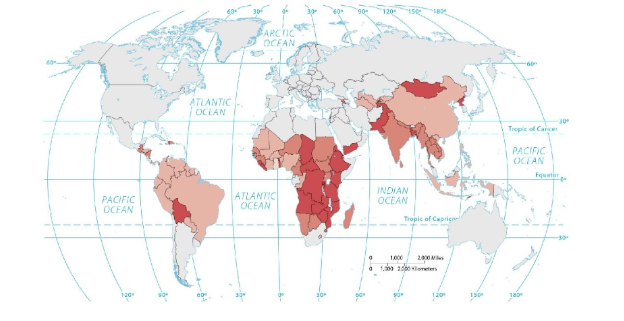
If darker shades represent higher values, this is most likely a map of:
a. per capita fish consumption.
b. percent of income spent on food.
c. change in number undernourished.
d. dietary energy consumption
e. percent undernourished.
e. percent undernourished.
Which is NOT a form of subsistence agriculture?
a. Pastoral Nomadism
b. Mediterranean
c. Intensive Wet Rice
d. Sustainable
e. Subsistence
b. Mediterranean
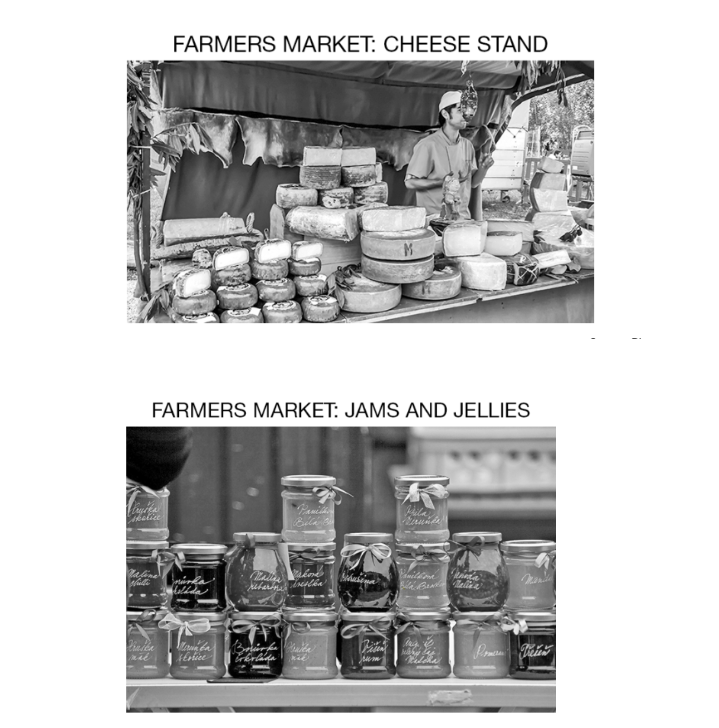
Which of the following best explains the economic advantage of the type of farm-produced goods shown in the images?
a. Compared to name-brand goods, farm-made agricultural goods are much lower in cost and provide significant value to consumers.
b. Compared to plain milk or fresh fruit, these value-added agricultural goods significantly increase the price of the farm products sold and increase earnings for farmers.
c. Compared to fresh produce, these packaged agricultural goods significantly increase the gross national income that is sourced from industrial production and bring financial wealth to farmers.
d. Compared to organic foods sold at specialty grocery stores, these goods are sold as natural foods and considered to be of equal value to consumers.
e. Compared to factory-made dairy products and condiments, these preservative-free goods have a decreased shelf life, which increases the prices of the goods sold.
b. Compared to plain milk or fresh fruit, these value-added agricultural goods significantly increase the price of the farm products sold and increase earnings for farmers.
Traditional labor-intensive agriculture often involves which of the following?
a. High levels of debt
b. Field terracing
c. Use of pesticides
d. Hybrid seeds
e. Mechanical plowing
b. field terracing
Agriculture practiced in California differs from forms practiced in other Mediterranean agricultural regions because in California
a. grapes are grown for wine production
b. farms rely on local labor
c. farms use more irrigation
d. wheat is grown in the winter as a cover crop
e. farms are smaller
c. farms use more irrigation
In which of the following countries is terracing LEAST likely to be used by farming groups to create additional space and minimize erosion on steep slopes?
a. The Philippines
b. Nepal
c. Greece
d. Niger
e. Peru
d. Niger
Which of the following best explains why the New England region, located in the northeastern United States, would specialize in market gardening agriculture rather than other types of agriculture, such as grain farming?
a. Market gardening zones allow farmers the flexibility to grow market gardening crops along with other grain crops.
b. Several large cities on the East Coast provide a growing market and shorter distances for transporting market gardening products.
c. Market gardening products can be easily transported to the primary market of California without spoiling.
d. Wheat farming would require more machinery, which conflicts with the environmental standards of many states in New England.
e. Farmers can specialize in market gardening products because of the rocky soil found in many New England states.
b. Several large cities on the East Coast provide a growing market and shorter distances for transporting market gardening products.
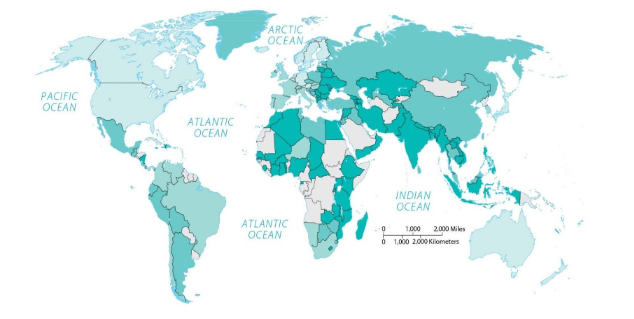
If darker shades represent higher values, this is most likely a map of:
a. percent of income spent on food.
b. dietary energy consumption.
c. per capita fish consumption.
d. percent undernourished.
e. change in number undernourished.
a. percent of income spent on food.
Which type of agriculture occupies the largest percentage of the world's land area?
a. pastoral nomadism
b. shifting cultivation (slash and burn)
c. dairying
d. intensive subsistence
b. shifting cultivation (slash and burn)
Pastoral nomads:
a. are expanding their territory in North Africa and the Middle East.
b. prefer sheep to goats because sheep require less water and will forage on virtually any vegetation
c. occupy only their own territory, moving with the seasons to find forage and water
d. consume mostly meat, rather than grain.
e. occupy different territory each year to find forage and water.
c. occupy only their own territory, moving with the seasons to find forage and water
Which of the following is not an important plantation crop?
a. rice
b. cotton
c. bananas
d. rubber
e. coffee
a. rice
The clearing of tropical rain forest for agriculture frequently results in:
a. long-term productive farmland
b. a shift to animal raising
c. large-scale immigration
d. an increase in the size of the ozone hole
e. better-managed commercial forests
b. a shift to animal raising
Mixing crops and livestock allows farmers to
a. distribute the workload of the crops and livestock evenly throughout the year.
b. generate 3/4ths of their income from the sale of livestock.
c. create a system where crops provide food for livestock and the livestock provide manure for crop fertilization.
d. all of the above.
d. all of the above.
Nomadic pastoralism is an extensive agricultural system practiced
a. in the tropical regions of Africa and Asia
b. in the dry regions of Africa and Asia
c. by Native American buffalo hunters
d. in the hinterlands of Australia
e. by people who shift location in pursuit of rain clouds
b. in the dry regions of Africa and Asia
Unlike other forms of commercial agriculture, plantations are
a. found primarily in less developed countries.
b. part of agribusiness.
c. situated in densely populated locations.
d. owned by people in less developed countries.
a. found primarily in less developed countries.
Which type of agriculture is practiced by the largest percentage of the world's people?
a. hunting and gathering
b. shifting cultivation
c. Plantation
d. intensive subsistence
e. pastoral nomadism
d. intensive subsistence
In the United States many farms are integrated into a large food production industry. This is known as
a. organic farming.
b. agribusiness.
c. food processing.
d. mechanized farming.
b. agribusiness.
While climate influences every agricultural practice, the form of agriculture most dependent on climate is:
a. livestock ranching
b. dairy farming
c. mediterranean
d. grain farming
e. truck and commercial farming
c. mediterranean
After corn, the most important crop in the U.S. mixed crop and livestock region is:
a. soybean
b. Barley
c. Rice
d. Wheat
a. soybean
Which type of agriculture is found primarily in less developed countries?
a. mixed crop and livestock
b. plantation
c. truck farming
d. commercial gardening
e. mediterranean
b. plantation
Commercial agriculture is distinguished from subsistence agriculture by all but which of the following?
a. farm size
b. heavy use of machinery
c. limited to no profit
d. low percentage of farmers in the labor force
e. output consumed on the farm
c. limited to no profit
Women played a crucial role in the domestication of plants because they
a. were agile climbers on the hillsides of the Fertile Crescent
b. knew how to achieve control over their environment
c. were interested in varying the diets of their families
d. traveled long distances from their home base
e. were engaged in collecting plant resources
e. were engaged in collecting plant resources
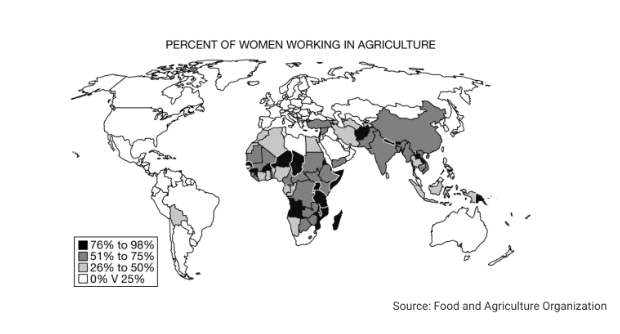
Based on the map, which of the following explains the similarities of the world regions where at least 51 percent of women work in agriculture?
a. These regions are composed of more-developed countries with large urban populations.
b. These regions are composed of less-developed countries with large rural populations.
c. These regions are in the Southern Hemisphere, in temperate climate zones.
d. These regions are composed of less-developed countries with small rural populations.
e. These regions are near the equator, in climate zones with high temperatures.
b. These regions are composed of less-developed countries with large rural populations.
What is the main reason why MDC farmers lack adequate income?
a. Lack of prime agricultural land
b. Surplus production exceeds the demand
c. The federal guidelines are too strict on livestock production
d. Agribusinesses undercut the small family farms
b. Surplus production exceeds the demand
What are the two main obstacles the LDC farmers face in the future (Choose 2)?
a. Agriculture supply cannot keep pace with natural increase rate
b. Agricultural products are produced in surplus and not a large enough global demand to be a viable economic exporter
c. Most excess food production in conducted on a plantation farm and shipped to MDC's and not consumer locally
d. Most of domestic consumption is based on global distribution
a. Agriculture supply cannot keep pace with natural increase rate
c. Most excess food production in conducted on a plantation farm and shipped to MDC's and not consumer locally
Why is the traditional classification of agriculture as a primary economic activity a problem when considering the geography of agriculture (Think...why agribusinesses are replacing small farms)?
a. Modern farmers use machinery.
b. Unlike mining, forestry, and other primary activities, agriculture has not been affected by industrialization.
c. Modern farmers are engaged in production, research, marketing, and some manufacturing of their products.
d. Agricultural employment is such a small fraction of the labor force in the industrialized countries that agriculture can no longer be thought of as a primary economic activity.
e. Traditional patterns of farming are disappearing.
c. Modern farmers are engaged in production, research, marketing, and some manufacturing of their products.
Which of the following is NOT a strategy of sustainable agriculture?
a. better integration of livestock and mixed crops
b. Increase use of genetically modified techniques
c. Which of the following is NOT a strategy of sustainable agriculture?
d. limited use of chemicals
b. Increase use of genetically modified techniques
According to the von Thünen model, timber production was located in the second ring from the city because of what factor?
a. labor intense harvesting methods
b. need for a vast area
c. product weight
d. perishability
c. product weight
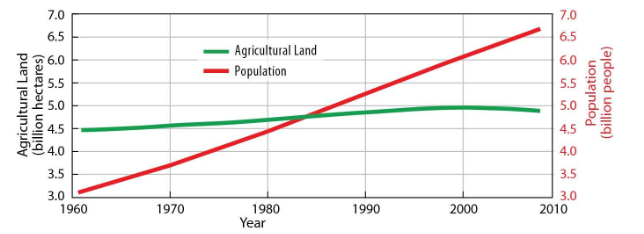
This figure helps to explain that for the last half century most increase in food production has come from:
a. expanding agricultural land
b. expanding exports
c. increasing fish harvests
d. increasing agricultural productivity
e. discovering new foods
d. increasing agricultural productivity
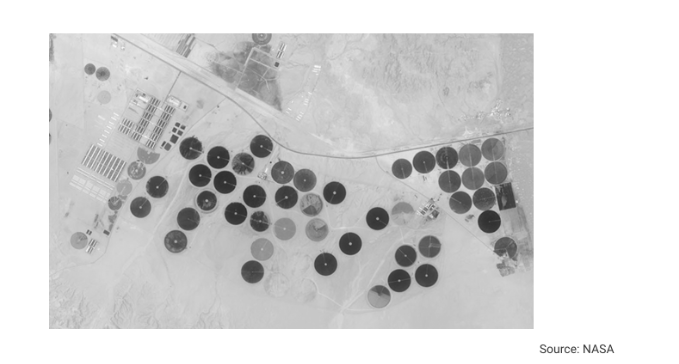
Based on the different types of land use shown in the image, which of the following best explains why soil salinization is a concern in the arid landscape shown?
a. Land is being farmed so intensively that soil nutrients are degraded to the point that crops will not grow.
b. Fields are left fallow after being farmed intensively so that nutrients in the soil may be replenished.
c. Irrigation increases the salt content of the soil, which disrupts the growth of crops and degrades soil fertility.
d. Multiple crops are being planted in the same field, which increases the chances of pest damage.
e. Forests are being cleared as land is repurposed for agricultural uses, which reduces biodiversity in the region.
c. Irrigation increases the salt content of the soil, which disrupts the growth of crops and degrades soil fertility.This answer is correct.
Farmers in more developed and less developed countries share which of the following problems?
a. surplus production
b. inadequate income
c. access to fertilizers
d. lack of equipment
b. inadequate income
Which of the following is the most often cited environmental benefit of the eat-local movement?
a. Fewer pesticides are used by farmers.
b. There is less demand for chemical fertilizers.
c. Less fossil fuel is used in transporting food to market.
d. It helps local and regional economies.
e. Less topsoil is lost to wind and water erosion.
c. Less fossil fuel is used in transporting food to market.
________ model is used by geographers to explain the importance of proximity to the market in the choice of crops to the commercial farm.
a. Sir Bidwell
b. Iqbel's
c. Von Thünen's
d. Whittlesey's
c. Von Thünen's
Which of the following activities is most likely to be found in the outermost zone of von Thünen's model of agricultural land use?
a. Extensive grain or stock raising
b. Dairying and market gardening
c. Mixed farming
d. Specialty farming
e. Subsistence farming
a. Extensive grain or stock raising
The primary factor in von Thünen's model for choosing commercial farm products is
a. Transportation costs and market location
b. land price.
c. Location of CBD
d. Infrastructural ammenities
a. Transportation costs and market location
Which of the following environmental problems is most associated with the African Sahel?
a. Water pollution
b. Flooding
c. Deforestation
d. Air pollution
e. Desertification
e. Desertification
Which of the following social or environmental impacts is most directly related to the use of chemicals in agriculture?
a. A decrease in the price of agricultural products due to lower labor costs associated with applying chemicals over widespread areas in one application
b. An increase in profits that is limited to farmers in developed countries
c. An increase in the use of genetically modified crops
d. An increase in land and water pollution from agricultural runoff
e. A decline in insect-borne diseases and improved health at the global scale
d. An increase in land and water pollution from agricultural runoff
Which of the following developments is predicted by the von Thünen model of land use around cities?
a. Large-scale growing of flowers and vegetables in the Netherlands
b. Extensive cattle raising in northern France
c. Large-scale rubber plantations in Malaysia
d. Very large dairy farms in Utah and southern Idaho
e. Large-scale commercial fishing in Japan
a. Large-scale growing of flowers and vegetables in the Netherlands
Which of the following best explains how the expansion of feedlots for raising cattle and mixed crop and livestock farms has affected environmental sustainability in rural areas?
a. Feed grains have eliminated potentially harmful invasive plant species from farmland.
b. Composted manure has introduced valuable nutrients into previously depleted soils.
c. Land development has increased the available water supply for other farming practices.
d. Concentrating large numbers of farm animals in small spaces has decreased the release of carbon dioxide in the atmosphere.
e. Runoff from animal waste has increased the pollution in local water supplies.
e. Runoff from animal waste has increased the pollution in local water supplies.
Which of the following agricultural practices has the most significant long-term environmental impact in tropical regions?
a. Burning extensive areas of forested land to create pasture, which decreases biodiversity
b. Moving livestock to higher pasture areas in the spring, which leads to soil degradation
c. Burning small areas of forested land for subsistence farming, which increases biodiversity
d. Clearing small patches of land to pasture dairy cows, which decreases water pollution from runoff
e. Building terraces on sloping land to grow rice, which destabilizes hillsides
a. Burning extensive areas of forested land to create pasture, which decreases biodiversity
Von Thünen emphasized which of the following factors in his model of agricultural land use?
a. Machinery cost
b. Fertilizer cost
c. Labor cost
d. Transportation cost
e. Seasonal fluctuations in prices of farm products
d. Transportation cost
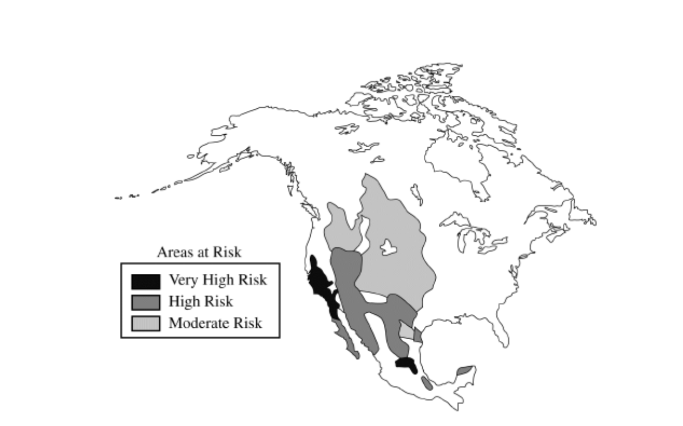
The shaded areas on the map above most likely indicate regions that are affected or threatened by which of the following?
a. Devolution
b. Desertification
c. Depopulation
d. Deforestation
e. Deindustrialization
b. Desertification
Question 22
Which of the following correctly explains the placement of an agricultural product within von Thünen’s agricultural land-use model?
a. Tomatoes are grown closest to the market because they spoil quicker than beef or grain.
b. Beef cattle are raised close to the market because meat spoils quickly.
c. Beef cattle are raised close to the market because land is cheapest closer to the market.
d. Grain is grown close to the market because it is bulky to transport.
e. Firewood is harvested far from the market because the best agricultural land is closer to the market.
a. Tomatoes are grown closest to the market because they spoil quicker than beef or grain.
Based on von Thünen’s model of rural land use in an isolated state, which statement explains the most suitable place for a farmer to purchase a large parcel of land necessary for raising livestock?
a. The ring closest to the market, because livestock are perishable goods and need to reach the market quickly.
b. The third ring, because the livestock would be closer to the suburban market areas with moderate transportation costs.
c. The ring farthest from the market, because the land is less expensive and outweighs transportation costs to get the livestock to market.
d. The ring closest to the market, because the land is more fertile for growing feed for livestock compared to other areas.
e. The second ring, because livestock are heavy and more expensive to transport to market.
c. The ring farthest from the market, because the land is less expensive and outweighs transportation costs to get the livestock to market.
The farther a dairy farm is from a large urban area the lower the percentage of output devoted to fresh milk. This occurs primarily because
a. transport costs are greater farther from the urban area.
b. the quality of soil is lower near an urban area.
c. land costs are lower farther from the urban area.
d. processed milk is less perishable.
e. market areas are located in the most accessible locations
d. processed milk is less perishable.
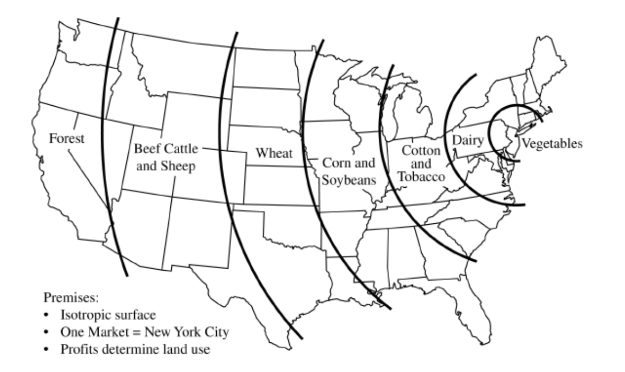
The above map shows von Thünen’s model applied to a map of the contiguous United States. Which of the following realities would NOT be accounted for by the theoretical predictions shown on the map?
a. Minnesota's corn belt region
b. Florida’s government has a Department of Citrus
c. Wyoming is a major cattle-ranching area.
d. New Jersey’s nickname is the Garden State.
e. California's San Joaquin Mixed Crop and LIvestock Valley
b. Florida’s government has a Department of Citrus
The participation of women in agriculture production:
a. Has had little effect on the lives of families in developing countries.
b. Has declined in those countries that practice intensive forms of agriculture.
c. Is extremely important since women grow over half the world's food supply
d. Has declined due to increased educational opportunities and the movement of women into factory work.
e. Has increased in developed countries but is very low in developing countries due to religious and cultural prohibitions against women working,
c. Is extremely important since women grow over half the world's food supply